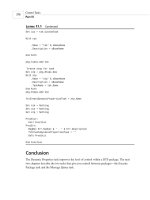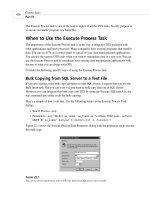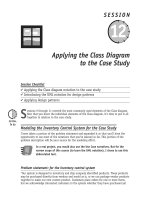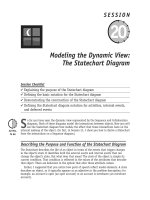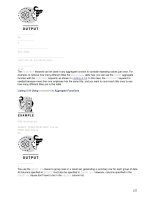Microsoft SQL Server 2000 Weekend Crash Course phần 5 pps
Bạn đang xem bản rút gọn của tài liệu. Xem và tải ngay bản đầy đủ của tài liệu tại đây (327.29 KB, 41 trang )
You can encrypt triggers or stored procedures to prevent anyone
from looking into your source code. Just add the modifier WITH
ENCRYPTION right before the AS keyword.
Recursive triggers
A trigger can call itself recursively (if the database option that allows it is set to
true). For example, if a FOR UPDATE trigger contains an UPDATE statement for the
base table, this trigger will be called again as this UPDATE executes, and again,
and yet again. The maximum number of recursive calls is 32, which is also the
maximum nesting depth. While a valid programming tool, recursive triggers can be
tricky to write and you should exercise caution in using them.
Besides implementing business logic, triggers are mainly used to
enforce referential integrity (see Session 5). Though the best
way to maintain referential integrity is normally to use the
FOREIGN KEY constraint, triggers and stored procedures become a
viable alternative in some situations. Check out Books Online or
some advanced books on SQL Server 2000 for some examples of
such situations.
Nested triggers
Triggers can be nested. They follow the same rules defined for stored procedures
and cannot exceed 32 levels. One example of nested triggers can be a table whose
FOR UPDATE makes an INSERT into the same table, thus invoking a FOR INSERT
trigger, which in turn invokes a FOR DELETE trigger. It is possible that one trigger
will invoke another that in turn invokes the first one, causing a so-called indefi-
nite loop. Because of the maximum depth of nesting levels, this loop will stop after
32 cycles. The SQL Server 2000 default setting allows nested triggers. You can dis-
able this option on the Server-level right-click menu by selecting Properties fol-
lowed by an option on the Server Settings menu, or by executing the following
system stored procedure:
exec sp_configure ‘nested triggers’, 0
Note
Note
Saturday Afternoon142
204840-9 ch12.F 8/28/01 12:53 PM Page 142
Disabling nested triggers will automatically disable recursive
triggers, regardless of the setting you may have in your database.
Recursive triggers are a special kind of nested triggers.
Managing Triggers
The easiest way to manage triggers is through a visual interface (see Figure 12-1).
You can view, modify, or delete a trigger. Behind the scenes, SQL Server will assem-
ble and execute a batch of T-SQL statements; you can, of course, also create and
execute these statements yourself.
Triggers are powerful, built-in tools for implementing business rules in the SQL
Server database as well as for enforcing referential integrity. I strongly recommend
reading Session 16, “Understanding Transactions and Locks,” before attempting
any real-life implementations.
Creating triggers
To create a trigger, simply run the code shown in Figure 12-2 from a Query
Analyzer window.
Dropping (deleting) triggers
To drop/delete a trigger, use the following syntax:
DROP TRIGGER <trigger name>
You can drop more than one trigger at the same time by specifying a list of trig-
gers. Dropping a trigger does not affect its base table.
You can remove a trigger by dropping it or by dropping the table
that it is associated with. When a table is dropped, all associated
triggers are also dropped.
Tip
Note
Session 12—Trigger Happy 143
Part III—Saturday Afternoon
Session 12
204840-9 ch12.F 8/28/01 12:53 PM Page 143
Modifying triggers
The easiest way to modify a trigger is to drop it and then create another one under
the same name. If, for whatever reason, you need to preserve the trigger’s internal
ID (a unique number under which the trigger is listed among system objects), you
can use the ALTER TRIGGER statement. The T-SQL code following the AS keyword
will replace the original code :
ALTER TRIGGER tr_TwentyPercentRule ON employees
AFTER UPDATE
AS
PRINT ‘NO MORE RULES’
You can quickly view the information about triggers defined on a
table by using the system stored procedure sp_helptrigger. The
syntax is as follows: exec sp_helptrigger <table name>
REVIEW
¼
Many different types of triggers exist; each has a different use.
¼
You manage triggers as you would any other SQL Server database objects:
either with T-SQL commands or through the Enterprise Console manager.
QUIZ YOURSELF
1. What is a SQL Server trigger?
2. How is a trigger different from a stored procedure?
3. What are the SQL Server trigger types?
4. In response to what events would a trigger be fired?
Tip
Saturday Afternoon144
204840-9 ch12.F 8/28/01 12:53 PM Page 144
Session Checklist
✔
Using different types of cursors
✔
Understanding the scope of cursors
✔
Setting cursor concurrency options
✔
Choosing the right cursor
T
his session introduces Transact-SQL cursors, a very powerful programming
tool for data manipulation. You will learn about different types of cursors,
their advantages and disadvantages, programming considerations affecting
cursors, and how to choose the right cursor for any given job.
Understanding Cursors
In the SQL Server environment sets are the most efficient means of accessing or
modifying data, and you should use them whenever possible. For everything else
there is a cursor. Cursor is an extension provided by SQL Server to enable you to
SESSION
Introducing Cursors
13
214840-9 ch13.F 8/28/01 12:53 PM Page 145
work with result sets returned by SELECT statements — one row at the time. From
examples in previous sessions you should have a general idea of what will be
returned by the following statement on the Pubs database:
SELECT * FROM authors WHERE state = ‘CA’
This statement returns a result set of 15 rows. This is the result set you are
working with and there is no way to access a single row within this result set
without losing the rest of the rows. That is, unless you are using a cursor. If you
want to update each record in a table differently, you either have to run a differ-
ent query for each row, or use a cursor.
You can request a cursor in SQL Server in two ways: inside the server itself by
using Transact-SQL statements, or via a client application by using one of the sup-
ported interfaces, such as Microsoft Active Data Objects, ODBC (Open Database
Connectivity), OLE DB (the latest database interface from Microsoft), or DB-Library
(a low-level programming interface to SQL Server). In this session I will concen-
trate mainly on server-side cursors created with Transact-SQL.
The basic syntax for declaring a simple cursor is similar to a standard T-SQL
batch statement:
DECLARE cur_California CURSOR FOR
SELECT * FROM authors WHERE state = ‘CA’
Since the primary reason for opening a cursor is to scroll it, all cursors are scrol-
lable (that is, you can navigate from record to record sequentially). In the interest
of preserving system resources the default scrolling is forward-only; if you need to
scroll backward, you open a specific type of cursor. (I’ll go into more detail about
cursor types later in this session.)
Once a cursor is declared you need to OPEN it so it can be populated with
records:
OPEN cur_California
Once the cursor is open you can access the data by scrolling the cursor. In order
to retrieve a row from a cursor you have to FETCH it as shown here:
FETCH NEXT FROM cur_California
FETCH instructs SQL Server to retrieve a single row from the result set contained
in the cursor. Once you’ve examined the content of this row it is time to move on
as follows:
WHILE @@FETCH_STATUS = 0
BEGIN
Saturday Afternoon146
214840-9 ch13.F 8/28/01 12:53 PM Page 146
The following code is executed as long as the previous FETCH succeeds:
FETCH NEXT FROM cur_California
END
You have to organize a loop to scroll the cursor and you also need to know
when to stop. The system function @@FETCH_STATUS will let you know when you
reach the end of the cursor: 0 means that a row was successfully FETCHed, and
anything else means that the FETCH NEXT statement failed. Once you are through
with the cursor you need to explicitly close and destroy it:
CLOSE cur_California
DEALLOCATED cur_California
Closing and de-allocating cursors is very important. An open cur-
sor takes up a lot of memory that will not be freed until the cur-
sor is closed and de-allocated; nor will you be able to open
another cursor with the same name.
If you run all the T-SQL statements introduced earlier in this session as a batch
from the Query Analyzer window, in your Results pane you will see 15 separate
rows as opposed to a single result set of 15 rows.
In the preceding sample you FETCHed the whole row. It is possible to FETCH
only the fields (columns) you are interested in; you can also declare a cursor on a
join. You can use any valid T-SQL SELECT statement to produce a cursor.
Here is an example of creating and scrolling a cursor containing records of the
last names and first names of the authors living in California, ordered alphabeti-
cally by last name:
USE Pubs
DECLARE @FirstNameVARCHAR(20)
DECLARE @LastName VARCHAR(20)
DECLARE cur_California CURSOR FOR
SELECT au_lname,au_fname FROM authors WHERE state = ‘CA’ ORDER BY
au_lname
OPEN cur_California
FETCH NEXT FROM cur_California INTO @FirstName, @LastName
WHILE @@FETCH_STATUS = 0
BEGIN
PRINT @LastName+ “,” + @FirstName
Note
Session 13—Introducing Cursors 147
Part III—Saturday Afternoon
Session 13
214840-9 ch13.F 8/28/01 12:53 PM Page 147
The following code is executed as long as the previous FETCH succeeds:
FETCH NEXT FROM cur_California INTO @FirstName, @LastName
END
CLOSE cur_California
DEALLOCATE cur_California
The result of this batch executed from the Query Analyzer will be a comma-
delimited list of all authors’ first and last names.
Using Different Types of Cursors
According to your particular needs you may choose one of the four following types
of cursors:
¼
Scrollable cursors
¼
Static cursors
¼
Dynamic cursors
¼
Keyset cursors
¼
Forward-only cursors
You specify the type of cursor you want through a specific modifier in the dec-
laration statement, as shown here:
DECLARE cur_California CURSOR STATIC FOR
SELECT au_fname, au_lname FROM authors WHERE state = ‘CA’
I discuss each type of cursor in the following sections.
Scrollable cursors
So far you have only scrolled the cursor forward. Forward-only is the default for
any cursor type that opens for which no options are specified. To get a scrollable
cursor that scrolls both ways, you should ask for one:
DECLARE cur_California CURSOR SCROLL FOR
SELECT au_fname, au_lname FROM authors WHERE state = ‘CA’
Saturday Afternoon148
214840-9 ch13.F 8/28/01 12:53 PM Page 148
Now you can move backward and forward. You can navigate a cursor using the
FETCH command.
¼
FETCH PRIOR — Moves to the previous record in the result set.
¼
FETCH FIRST — Moves to the first record in the result set.
¼
FETCH LAST — Moves to the last record in the result set.
¼
FETCH ABSOLUTE number — Retrieves a specific position within the result
set (FETCH ABSOLUTE 4, for example, retrieves the fourth record from the
beginning.) The number you specify must be a positive integer.
¼
FETCH RELATIVE number — Works like FETCH ABSOLUTE, with the exception
that the count starts from the current row: If you are on the fourth record
in your result set FETCH RELATIVE 3 will take you to the seventh row from
the beginning. The number you specify must be a positive integer.
You should always check @@FETCH_STATUS to verify that the
record was retrieved. At the beginning of the result set FETCH
PRIOR does not yield any results and @@FETCH_STATUS is -1;
when you are trying to fetch a row that was deleted after the
cursor was opened, @@FETCH_STATUS is -2. The value of
@@FETCH_STATUS is global to all cursors created on a particular
connection, meaning that all cursors you happen to create and
that have not yet been destroyed will affect its value.
Static cursors
Static cursors represent snapshots of the data: Once created, a static cursor does not
reflect any subsequent changes to the underlying data. Static cursors in SQL Server
are always read-only. They are the least resource-intensive scrollable type of cursor.
Dynamic cursors
Dynamic cursors, as their name implies, never lose a contact with the data from
which they were created. Every modification (INSERT, UPDATE, or DELETE) is visi-
ble through this cursor — that is, if it has been made through the cursor itself or
committed to the database by other clients (to see uncommitted modifications
made by others to the same set of data requires more advanced techniques). The
dynamic cursor is always scrollable.
Tip
Session 13—Introducing Cursors 149
Part III—Saturday Afternoon
Session 13
214840-9 ch13.F 8/28/01 12:53 PM Page 149
Keyset cursors
KEYSET cursors behave almost exactly like DYNAMIC cursors, with the exception
that the KEYSET cursors are — well — keyset-based. A keyset is a unique set of
columns that the cursor’s SELECT statement contains, and only these values are
guaranteed to be there while you are scrolling the cursor. When you OPEN the cur-
sor the list of all key values is created in TempDB, a workbench for all databases in
the SQL Server system. The keyset membership is fixed — after the cursor is
OPENed, only the data present at that moment will be available for viewing.
Forward-only cursors
The forward-only cursor does not support scrolling, which means that you can only
use FETCH NEXT — there’s no going back. The cursor is not built upon executing
the OPEN statement; the FETCH NEXT command fetches the row directly from the
database.
Understanding the Scope of the Cursors
By default, the cursor is global for the connection it was created with. This means
that unless you close and de-allocate the cursor, you can use it throughout every
T-SQL batch you execute on the connection. While this is certainly a convenient
feature, you must be careful not to keep the cursor open longer than necessary.
This is because SQL Server will generate an error if a T-SQL block or batch tries to
open the same cursor before you close it. If you forget to de-allocate the cursor it
will be hanging around until the connection to the SQL Server is closed.
If you want to create a local version of a cursor you must explicitly state this at
the database-settings level by setting CURSOR_DEFAULT to LOCAL (it is set to
GLOBAL by default), or specifying it in the declaration of the cursor, as in the fol-
lowing example:
DECLARE cur_California CURSOR LOCAL FOR
SELECT * FROM authors WHERE state = ‘CA’
Local cursors are visible only within the batch with which they were created
and last only as long as it takes that batch to execute; they are implicitly
de-allocated afterwards.
Saturday Afternoon150
214840-9 ch13.F 8/28/01 12:53 PM Page 150
If you need to perform another cursor operation while scrolling a
cursor, feel free. Unlike nested stored procedures or triggers, cur-
sors are not limited to any nesting depth. Just keep in mind that
the @@FETCH_STATUS function is global for the whole connection
and that both cursors will affect it.
Setting Cursor Concurrency Options
Concurrency can become an issue in a fast-paced environment wherein many users
are working on the same data set. How can users be sure that their changes are not
being accidentally overridden by other users? By preventing anyone from modifying
the record until you’re done — in other words, by placing a lock on it —you can pro-
tect your changes. If you think that there’s a good chance that somebody else will
try to modify the data while you are working with them, you may try other options.
SQL Server 2000 supports four concurrency options:
¼
READ_ONLY — Use this option when you need only to see the data, not to
modify it; this option uses the least system resources.
¼
OPTIMISTIC WITH VALUES — Use this option when you do want to update
your data but estimate that the chances that a second user might try to
update the same record at the same time are very slim: Any other user will
get an error notification upon trying to update values that you’ve just
changed.
¼
OPTIMISTIC WITH ROW VERSIONING — Use this option when you are still
optimistic and prepared to take your chances, but want to make sure that
only the whole row can be updated, not just some fields within it.
¼
SCROLL_LOCK — Use this option when you trust no one: Nobody can mod-
ify a thing in the result set affected by your cursor until you are through
with it.
Unless you are using a cursor within a transaction (see Session 16), the cursor
does not lock the records it was created against. This means that while you are
scrolling your cursor somebody else can modify the underlying data. Depending on
the type of cursor you are using you might not be aware of the changes until you
close the cursor and reopen it. DYNAMIC cursors let you see the changes as they
come — but you must take precautions in order to manipulate them correctly. By
placing a lock on the underlying records you effectively deny anyone access to the
Tip
Session 13—Introducing Cursors 151
Part III—Saturday Afternoon
Session 13
214840-9 ch13.F 8/28/01 12:53 PM Page 151
records while you are working with them. You can lock the whole result set speci-
fied by the SELECT criteria, as in the following example:
DECLARE cur_California CURSOR SCROLL SCROLL_LOCK FOR
SELECT * FROM authors WHERE state = ‘CA’
This will prevent other users from modifying the data, although they will still
be able to view it.
No strict rules determine which concurrency option you should choose in any
given situation. You need to take into consideration the desired throughput, fre-
quency of updates, available system resources, system load, and so on.
Choosing the Right Cursor
You have a wide range of opinions when you are deciding which cursor to use or
even whether to use cursors at all. The choices can be overwhelming but they do
not have to be. Consider these priorities and the tradeoffs they entail:
¼
For data consistency, consider locking records.
¼
For system performance, consider using the STATIC or READ_ONLY option.
¼
For code maintainability, ask yourself this: Is my code too complex and
convoluted?
You will certainly come up with your own set of priorities. As a rule of thumb,
if you can avoid using cursors — do it. If you do need to perform row-by-
row operations, then consider your options: use the STATIC cursor with the
READ_ONLY option when you only want to look at the data, the DYNAMIC
cursor when you need to be aware of changes in the underlying data, and
the SCROLL_LOCK cursor when you need to shield your data from any
intrusion while you are working on them.
REVIEW
¼
Cursors are powerful tools in your Transact-SQL toolbox that operate row
by row.
¼
The four different types of cursors differ in terms of how they communi-
cate with the data they were created for. You need to choose an appropri-
ate type of cursor for the task at hand.
Saturday Afternoon152
214840-9 ch13.F 8/28/01 12:53 PM Page 152
¼
Cursors can be either global or local. You can set the visibility scope of the
cursor through database properties or through the cursor declaration. The
default setting is GLOBAL.
¼
When using cursors you need to pay attention to concurrency issues: Other
users can modify the underlying records while you are working on the
data set.
QUIZ YOURSELF
1. How are cursors different from T-SQL batch statements?
2. What are the four basic types of cursors?
3. What is the purpose of the @@FETCH_STATUS system function?
4. What is the default scope of a cursor? How can you change it?
5. Why should you care about concurrency issues?
Session 13—Introducing Cursors 153
Part III—Saturday Afternoon
Session 13
214840-9 ch13.F 8/28/01 12:53 PM Page 153
214840-9 ch13.F 8/28/01 12:53 PM Page 154
Session Checklist
✔
Using indexes
✔
Designing an index
✔
Creating and deleting an index
✔
Managing an index
Y
ou can greatly improve database performance by designing and implement-
ing proper indexes. In this session you will learn about the different types
of indexes and general index-design considerations, as well as how to opti-
mize and manage an index.
Using Indexes
An index in the database does not differ much from an index in the phone book. It
serves the same purpose: speeding up the search process. Imagine flipping through
each and every page to find a particular phone number in a thousand-page phone
SESSION
Understanding Indexes
14
224840-9 ch14.F 8/28/01 12:53 PM Page 155
book with randomly assembled phone numbers and then think of finding the same
number quickly in a phone book wherein the records are organized alphabetically by
last name. This is the difference an index can make to your database performance.
You create an index for a table or a view. You can create it either for a single
column or for a combination of columns. Indexes are stored separately from tables,
which increases overall database size. Information about every index defined for
the tables in a particular database is stored in the sysindexes system table for that
database. You can create an index for virtually any data type except bit, ntext,
text, and image.
SQL Server automatically creates an index for the table’s primary key. The total
number of indexes you can define for a single table is 250 (this includes one clus-
tered index and 249 non-clustered indexes — I’ll explain the distinction later in
this session).
Give careful consideration to the column(s) you choose for an index: A properly
selected index can increase performance tenfold, while a poorly selected index can
actually slow down your database.
Clustered indexes
When you create a clustered index for a table the data in this table are physically
ordered around this key. This explains why you can have only one clustered index:
Once your phone book is ordered alphabetically by last name you cannot order it
by first name — at the same time.
When you create a clustered index all the rows in the table must be shuffled to
reflect that index. This operation is fairly resource-intensive and requires some
free swap space on your hard drive; also, be aware that all previously declared
non-clustered indexes will be dropped.
A clustered index is usually created on a primary key, though you have the
power to override this default behavior and create a clustered index on any named
column. The only requirement is that the values in the column be unique; if the
values are not unique the efficiency of the index will be greatly diminished,
because SQL Server will create a secondary index on the rows that have duplicates
in the primary index.
A clustered index is particularly efficient for frequent searches for a specific
value: The table is physically sorted (clustered) on the column containing this
value, or for the ranges of values, because rows containing the values within a
range will be grouped together.
Saturday Afternoon156
224840-9 ch14.F 8/28/01 12:53 PM Page 156
Non-clustered indexes
A non-clustered index is merely a pointer to the row containing data. It corresponds
to the index of a textbook: You find the keyword and then go to the specified page.
Non-clustered indexes do not affect the order of the rows in the table. When you
make a request for a particular column, SQL Server searches through the index, finds
the actual records and goes directly there. This is not as efficient as searching with a
clustered index but is still far superior to looking through the table record by record
in search of a value. A non-clustered index is especially helpful when the query is
searching for an exact value.
You can create multiple non-clustered indexes for different columns or combina-
tions of columns and use them in different queries.
SQL Server 2000 enables you to define an index on computed
columns. This is rather an advanced feature: Refer to Books
Online for a discussion of the computed-columns indexes.
Designing an Index
While it is always a good idea to have indexes — a clustered index and one or more
non-clustered indexes — you should give some consideration to the design issues.
Not all indexes are created equal: Some will speed up operations while others
might slow it down. In order to choose proper columns for indexing you must have
intimate knowledge of the database structure and business logic. Ask these ques-
tions when it comes to choosing columns: Which data are accessed? How often?
Are the data in the table static or do they change all the time? Is the value
unique? Is it too long?
Ideally, you should run SQL Server Profiler to determine what types of queries
are run against your database, and then use the Index Tuning Wizard, which sug-
gests the columns to use for the index (these techniques will be described in
Session 26, which deals with tuning and optimization).
Until you gain some experience in using the Index Tuning Wizard, some simple
rules can help you make a choice. You should create an index (either clustered or
non-clustered) for the following items:
Note
Session 14—Understanding Indexes 157
Part III—Saturday Afternoon
Session 14
224840-9 ch14.F 8/28/01 12:53 PM Page 157
¼
Large tables containing more than one hundred rows
¼
Frequently searched-for columns
¼
Columns used in aggregate functions
¼
Columns used in GROUP BY and ORDER BY clauses
¼
Columns used in JOIN queries
You should not create an index for:
¼
Small tables
¼
Columns rarely or never used in queries
¼
Columns containing long strings of data
¼
Columns in which values are updated frequently
If you have a primary key in your table (and it is a good idea to have one) you
already have a clustered index: the same applies if you have defined a UNIQUE
constraint (see Session 15). You should create a clustered index on frequently
searched unique keys, columns with strong selectivity (a large count of unique val-
ues), and columns used by several different queries.
The prime candidates for non-clustered indexes are foreign keys, columns used
in the WHERE clause, columns used in aggregate functions, and columns returning
small result sets.
Creating and Deleting an Index
Like most SQL Server database objects, an index can be created in two ways: with
Transact-SQL statements, or visually, through a wizard (which creates the equiva-
lent T-SQL statements for you).
To create an index visually using the wizard, follow these steps:
1. Select Enterprise Manager ➪ Tools ➪ Create Index Wizard. The Welcome
screen briefly explains the other steps you will follow while creating the
index. Click Next.
Saturday Afternoon158
224840-9 ch14.F 8/28/01 12:53 PM Page 158
2. The next screen asks you to select a database and a table for which you
wish to create an index. (I have selected Pubs and Titles in Figure 14-1.)
Click Next.
Figure 14-1
Selecting a database and a table.
3. The next screen displays all the information about existing indexes for
the selected table (see Figure 14-2). Make sure that you are not attempt-
ing to create an index on the same columns. Click Next.
Session 14—Understanding Indexes 159
Part III—Saturday Afternoon
Session 14
224840-9 ch14.F 8/28/01 12:53 PM Page 159
Figure 14-2
Inspecting existing indexes.
4. The next screen displays the structure of the selected table. You can
choose the columns you would like to include in your index (see Figure
14-3) as well as the sort order (ascending or descending, ascending being
the default). Click Next.
Saturday Afternoon160
224840-9 ch14.F 8/28/01 12:53 PM Page 160
Figure 14-3
Selecting columns and sort order.
5. The next screen enables you to specify the index options: clustered or
non-clustered, unique or non-unique, default or custom fill factor (see
the Note in this section). Figure 14-4 shows this screen. Click Next.
Session 14—Understanding Indexes 161
Part III—Saturday Afternoon
Session 14
224840-9 ch14.F 8/28/01 12:53 PM Page 161
Figure 14-4
Specifying the index options.
The fill factor specifies how full the page should be before
another page is allocated for the growing index. The fill factor
option is provided for fine-tuning; in the majority of situations
you should use the default.
6. Every object in SQL Server is supposed to have a name (see Figure 14-5).
Name your index and, if more than one column is used for the index,
select the order in which the columns will appear. Click Finish.
I suggest using some kind of descriptive name (such as
titles_id_nc_title_type) for your indexes. This will help you
remember the columns for which you created the index, whether
the index is clustered or non-clustered, whether it is created or
primary, and so on.
Tip
Note
Saturday Afternoon162
224840-9 ch14.F 8/28/01 12:53 PM Page 162
Figure 14-5
Creating the index.
You also can create the same index using pure Transact-SQL by issuing the fol-
lowing commands:
CREATE NONCLUSTERED INDEX titles_id_nc_title_type
ON titles (title,type)
The full syntax for creating an index is more complex: You can specify many
options, such as FILLFACTOR, IGNORE_DUP_KEY, and more. Refer to Books Online
for the complete list of options.
To remove an index you can execute a Transact-SQL statement like the following:
DROP INDEX titles.titles_id_nc_title_type
Note that the index name is preceded by the table name for which this index
was created. To drop indexes created with PRIMARY KEY and UNIQUE constraints,
you must first drop the constraints (see Session 15). To drop the index from the
Enterprise Manager console, refer to “Managing an Index,” the next section in this
session.
Session 14—Understanding Indexes 163
Part III—Saturday Afternoon
Session 14
224840-9 ch14.F 8/28/01 12:53 PM Page 163
Managing an Index
Once your index is created you manage it from the Enterprise Manager console.
Select a table and from the right-click menu select Manage Indexes (see
Figure 14-6).
Figure 14-6
Managing indexes.
From the Manage Indexes window you can rename the index, change its options
(such as fill factor), or delete (drop) it altogether.
You also can use system stored procedures to retrieve information about indexes
on a particular table, as shown here:
USE Pubs
EXEC sp_helpindex Titles
Saturday Afternoon164
224840-9 ch14.F 8/28/01 12:53 PM Page 164
Finally, you can use the system stored procedure sp_rename to rename the
index with the following syntax:
sp_rename ‘titles.sample_index’, ‘titles.new_index’,’INDEX’
SQL Server will display the following message: “Caution: Changing any part of
an object name could break scripts and stored procedures.” You’ll receive a report
of the status and find out whether or not the object was renamed.
REVIEW
¼
Indexes created for a particular table can greatly speed up queries on that
table.
¼
You can create one clustered and up to 249 non-clustered indexes for a table.
¼
SQL Server automatically creates a clustered index for a primary-key column;
it is good practice to have a primary key defined for virtually every table.
¼
You must be very careful when selecting the columns for which to build an
index, as a poor choice can slow down the query.
¼
You can create an index either with the Create Index Wizard or with raw
Transact-SQL; both methods produce identical results.
¼
Once you have created an index, you can manage it through the Index
Manager or by using system stored procedures.
QUIZ YOURSELF
1. What is an index and why do you need it?
2. How many indexes can be created for a table?
3. What’s the difference between clustered and non-clustered indexes?
4. What columns should you consider for a clustered index?
5. In what situations do you not want an index on your table?
Session 14—Understanding Indexes 165
Part III—Saturday Afternoon
Session 14
224840-9 ch14.F 8/28/01 12:53 PM Page 165
224840-9 ch14.F 8/28/01 12:53 PM Page 166



